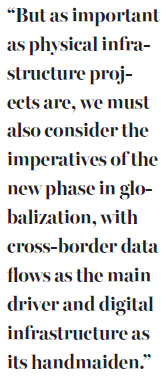Switched on to digital trans-Pacific route
Updated: 2016-03-11 08:09
By Jorge Heine(China Daily Europe)
|
|||||||||
Governments' agreement to look into laying fiber-optic cable from China to Chile good for Latin America
Rather than slowing down, globalization is morphing. As Digital Globalization: The New Era of Global Flows, a recent report from McKinsey Global Institute, tells us, digital flows are now more economically significant than trade in goods.
In an ever-more-connected world, cross-border bandwidth use has grown 45 times in the past decade. The fiber-optic cables that crisscross the world today are the modern-day equivalent of the 19th century railway tracks that made it possible to populate and develop vast swathes of the five continents.
Nowadays, 90 percent of Internet traffic circulates on these submarine cables that link continents, modern highways that allow us to communicate almost in real time. Over the past 25 years, a vast network of cables has been built across the oceans and along the coasts, with dramatic effects on the lives of people in all conditions.
Yet a look at a world map with the layout of fiber-optic cables shows an anomaly. Although they connect much of the world, not one directly links Asia with South America (or Latin America, for that matter). Over the past 15 years, trade and investment flows between Asia and Latin America have soared, and China has been at the center of it, accounting for about half of the nearly $500 billion worth of trade.

However, Internet communications between Latin American countries and China need to be routed through North America. At a time when South-South economic exchanges are more significant than North-South ones, this needs to change.
Pedro Huichalaf, the Chilean vice-minister of telecommunications, recently visited China and signed a preliminary agreement with Lin Nianxiu, his counterpart at the National Development Reform Commission. The agreement includes a commitment to a feasibility study on a trans-Pacific fiber-optic cable that would link China and Chile, perhaps from Qingdao to Valparaiso.
Chile is the country with the highest Internet penetration in Latin America (more than 70 percent, and a 127 percent mobile penetration rate) and is ideally positioned as a digital hub for the region.
China is making the transition from being the world's factory to that of a hub for these data flows, the driving force of the "fourth industrial revolution". It is now ranked seventh in the world in McKinsey's Connected Index, up from 25th a few years ago. So it is well-placed to drive such an ambitious project, which would entail laying 19,000 kilometers of fiber-optic cable across the Pacific Ocean.
Such a project would also give impetus to links between Asia and Latin America, at a time when the end of the commodities supercycle, and the flattening of trade in goods more generally, has put a dampener on trans-Pacific trade (global trade in goods as a share of world GDP declined from 26.6 percent in 2007 to 24.6 percent in 2014). As China prioritizes innovation and services as the drivers of its economy, Latin American countries should keep in mind the implications of this for their own way forward.
China's Belt and Road Initiative, the Asian Infrastructure Investment Bank and the New Development Bank are all projects that show China's commitment to infrastructure development in the global south. Highways, railways and maritime routes have been highlighted until now as likely centerpieces of their initial project portfolio. But as important as physical infrastructure projects are, we must also consider the imperatives of the new phase in globalization, with cross-border data flows as the main driver and digital infrastructure as its handmaiden.
By linking Asia and Latin America, such a trans-Pacific fiber-optic cable between China and Chile would do much to spur growth and development on both sides of the ocean.
The author is the Chilean ambassador to China. The views do not necessarily reflect those of China Daily.
Today's Top News
Inspectors to cover all of military
Britons embrace 'Super Thursday' elections
Campaign spreads Chinese cooking in the UK
Trump to aim all guns at Hillary Clinton
Labour set to take London after bitter campaign
Labour candidate favourite for London mayor
Fossil footprints bring dinosaurs to life
Buffett optimistic on China's economic transition
Hot Topics
Lunar probe , China growth forecasts, Emission rules get tougher, China seen through 'colored lens', International board,
Editor's Picks

|

|

|

|

|

|







